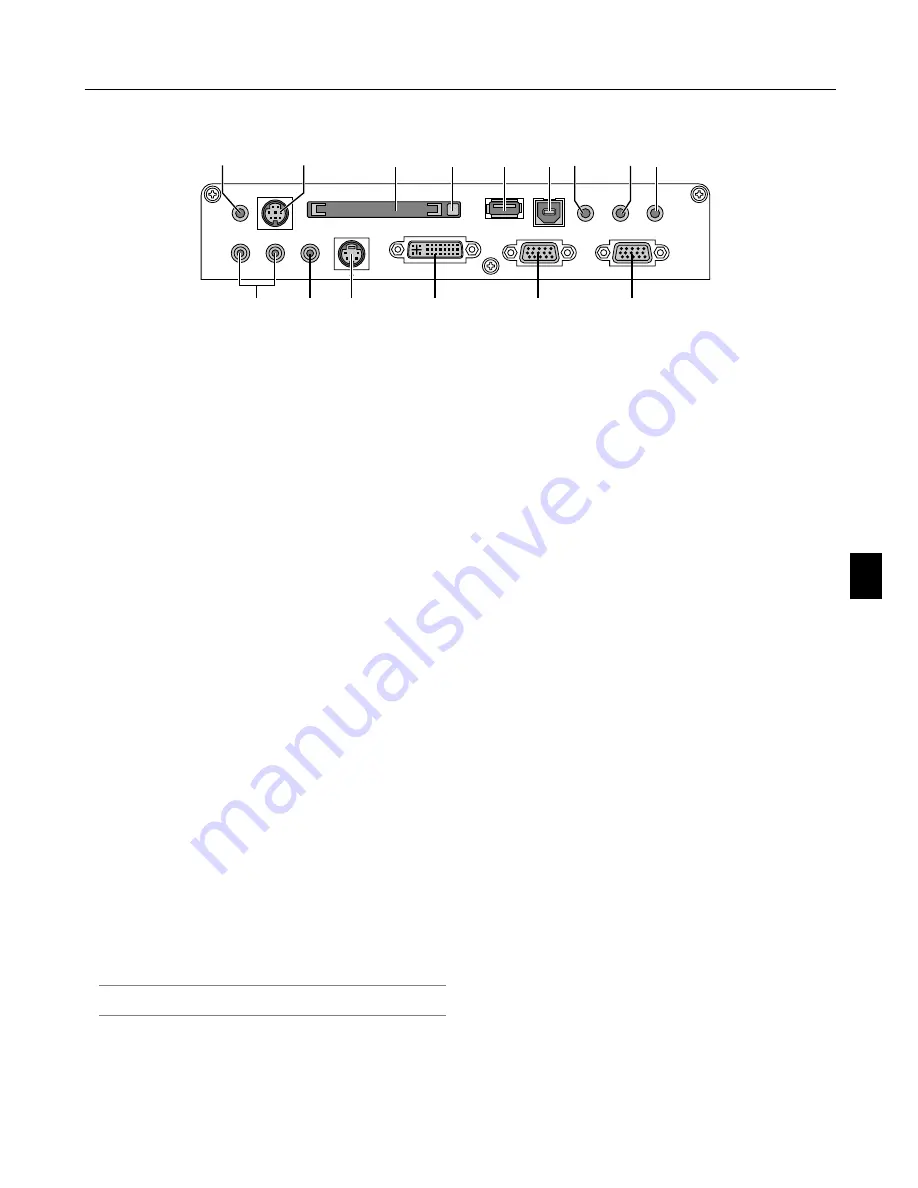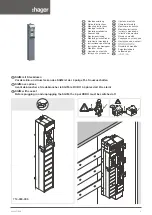
1-5
1. RGB IN / Component Input Connector (Mini D-Sub 15 Pin)
Connect your computer using the supplied RGB cable. This
connector also supports a component signal and SCART out-
put signal. See page 2-4 for more details.
2. RGB AUDIO IN Mini Jack (Stereo Mini)
This is where you connect audio output from your computer
or DVD player. A commercially available audio cable is re-
quired.
3. DVI-I IN Connector (DVI-I 24 Pin)
Connect a computer with a DVI output using the supplied DVI-
D cable.
This connector can be used to accept digital and analog sig-
nal output from a computer with a DVI connector.
4. DVI-I AUDIO Input Mini Jack (Stereo Mini)
This is where you connect the audio output from your com-
puter when connected to the DVI input. A commercially avail-
able audio cable is required.
5. RGB OUT Connector (Mini D-Sub 15 Pin)
You can use this connector to loop your computer image to
an external monitor from the RGB input source.
6. AUDIO OUT Mini Jack (Stereo Mini)
Connect an additional audio equipment here to listen to audio
coming from your computer, Video or S- Video input.
Note that there is no audio output from this jack during Standby
and Idle.
7. S-VIDEO IN Connector (Mini DIN 4 Pin)
Here is where you connect the S-Video input from an external
source like a VCR.
NOTE: S-Video provides more vivid color and higher resolution than
the traditional composite video format.
8. VIDEO IN Connector (RCA)
Connect a VCR, DVD player, laser disc player, or document
camera here to project video.
Terminal Panel Features
PC CARD
AUDIO IN
R
L
/MONO
VIDEO IN
S-VIDEO IN
DVI-I IN
RGB IN
RGB OUT
DVI-I
RGB
AUDIO IN
USB
AUDIO OUT
PC CONTROL
REMOTE
IN
1
5
6
12
13
15
14
3
7
8
9
2
4
10
11
9. VIDEO AUDIO IN Jacks (RCA)
L/MONO: This is your monaural or left channel audio input
for stereo sound coming from the VIDEO source.
R:
This is your right channel audio input for stereo
sound from the VIDEO source.
10. REMOTE IN Jack (Mini Jack)
Connect your remote control cable here for wired operation.
11. PC CONTROL Port (Mini DIN 8 Pin)
Use this port to connect your PC to control your projector via
a serial cable. This enables you to use your PC and serial
communication protocol to control the projector. The NEC op-
tional serial cable (CA03D) is required to use this port. You
can also control the projector by using Dynamic Image Utility
2.0 included on the supplied CD-ROM.
To do so you must first have Dynamic Image Utility 2.0 in-
stalled on your PC. If you are writing your own program, typi-
cal PC control codes are on page 10-4. A cap is put on the
port at the factory. Remove the cap when using the port.
12. USB Port (Type B)
Connect this port to the USB port (type A) of your PC using
the supplied USB cable. You can operate your computer's
mouse functions from the remote control.
13. USB Port (Type A)
Connect a commercially available mouse that supports USB.
You can operate the menu or Viewer with the USB mouse via
this port.
Note that this port should not be connected to a computer
and that there may be some brands of USB mouse that the
projector does not support.
14 . PC CARD Slot
Insert a PC card, commercially available LAN card or NEC
optional wireless LAN card here.
15. PC CARD Eject Button
Press to eject a PC card partially.
1. Introduction
Summary of Contents for WT600 - XGA DLP Projector
Page 1: ...WT600 Projector User s Manual...
Page 77: ...Printed in Japan 7N8P3012...














































